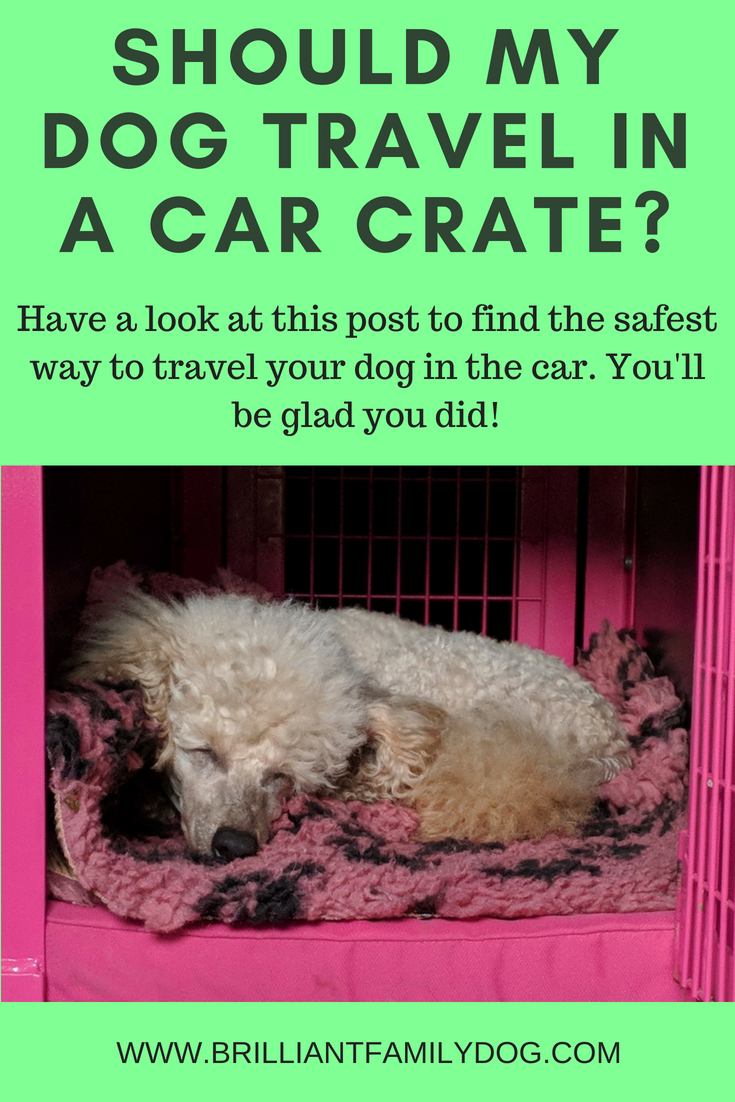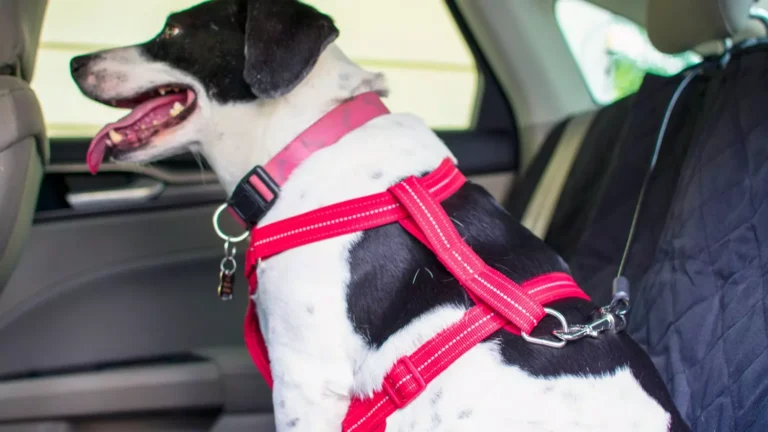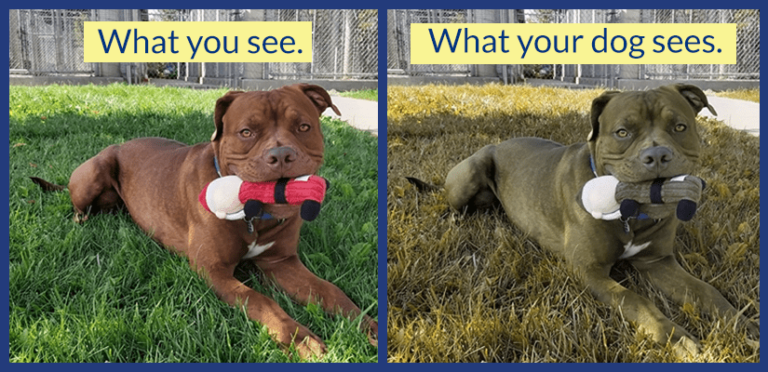What is the Safest Way to Travel With a Dog in the Car?: Top Tips
The safest way to travel with a dog in the car is to use a secured pet carrier or harness. These options help prevent distractions and keep your dog safe in case of sudden stops or accidents.
When traveling with your furry companion, it’s crucial to prioritize their safety and well-being. By taking proper precautions and using the right equipment, you can ensure a smooth and secure journey for both you and your pet. Let’s explore some essential tips and guidelines for traveling safely with your dog in the car.

Credit: www.batcopetsitting.com
Introduction To Safe Canine Car Travel
When it comes to traveling with your furry friend, ensuring their safety in the car is paramount. Safe canine car travel is not only a matter of responsibility, but it also contributes to a stress-free and enjoyable journey for both you and your dog. In this article, we’ll explore the best practices for ensuring your dog’s safety while traveling in a vehicle, as well as the potential risks associated with improper transportation methods.
Importance Of Dog Safety On The Road
Ensuring the safety of your dog while traveling is crucial for their well-being and the overall security of all passengers. Properly securing your dog in the car can prevent distractions for the driver, reduce the risk of injury to the dog in the event of sudden stops or accidents, and ultimately ensure a smoother and more comfortable journey for everyone onboard.
Risks Of Improper Dog Transportation
Improper transportation of dogs in a vehicle can lead to various risks and hazards. Unrestrained dogs can cause distractions to the driver, leading to potential accidents. Moreover, in the event of a collision, an unsecured dog can become a projectile, posing a threat to both themselves and other passengers in the car. It’s essential to be aware of these risks and take appropriate measures to address them.
Choosing The Right Restraint
Choosing the right restraint is crucial for ensuring the safety of your dog in the car. Discover the safest way to travel with your furry friend by using a secure and comfortable restraint system that keeps them protected and minimizes distractions while driving.
Harnesses Vs. Carriers: Pros And Cons
When it comes to choosing the right restraint for your dog in the car, you have two main options: harnesses and carriers. Each option has its own set of pros and cons that you should consider before making a decision. Harnesses: One of the most popular choices for restraining dogs in the car is a harness. Harnesses are designed to secure your dog comfortably and safely while allowing them some freedom to move around. Here are some pros and cons of using a harness:- Pros:
- Provides better protection in case of an accident
- Allows your dog to sit, stand, or lie down comfortably
- Reduces the risk of injury by preventing your dog from being thrown around the car
- Can be used for walking your dog outside the car as well
- Cons:
- May not be suitable for dogs who tend to chew or escape from harnesses
- Some dogs may find it uncomfortable or restrictive
- Not all harnesses are crash-tested, so it’s important to choose a reliable and certified one
- Pros:
- Keeps your dog contained and prevents them from distracting the driver
- Offers a cozy and familiar environment for your dog
- Provides protection from debris or objects in case of sudden stops or accidents
- Can be used as a comfortable resting place for your dog during travel
- Cons:
- Some dogs may feel confined or anxious in a carrier
- Not suitable for larger dogs or dogs who prefer more freedom of movement
- May take up significant space in the car, limiting passenger or cargo capacity
Selecting The Best Size And Fit For Your Dog
When choosing a restraint for your dog, it’s crucial to consider the size and fit. The right size and fit will ensure that the restraint is effective and comfortable for your furry friend. Size: The size of the restraint should correspond to your dog’s measurements, taking into account their weight, chest size, and length. It’s essential to refer to the manufacturer’s sizing guide and measure your dog accurately to ensure a proper fit. Fit: A well-fitted restraint should allow your dog to move comfortably while still providing the necessary safety. Make sure the harness or carrier is snug but not too tight, allowing your dog to breathe and stretch without any restrictions. It’s important to regularly check the fit and adjust the restraint as your dog grows or changes weight. By choosing the right restraint and ensuring the correct size and fit, you can provide a safe and enjoyable travel experience for both you and your furry companion. Whether you opt for a harness or a carrier, prioritize your dog’s safety and comfort to make every car journey a pleasant one.Installation Of Dog Restraints
The installation of dog restraints in your car is crucial for the safety of both your pet and passengers.
Securing Harnesses Correctly
When securing harnesses, make sure they fit snugly to prevent your dog from moving around too much.
Proper Carrier Placement And Anchoring
Choose a carrier that fits your dog’s size and is placed securely in the car to prevent shifting during the journey.
Training Your Dog For Car Rides
For the safest way to travel with a dog in the car, ensure to use a crash-tested crate or a seat belt harness to secure your furry companion. Avoid letting them roam freely to prevent distractions and potential accidents while on the road.
Training Your Dog for Car Rides Acclimating Your Dog to Restraints When it comes to traveling with your furry friend in the car, safety should always be a top priority. One of the most important aspects of ensuring a safe journey is training your dog to be comfortable and well-behaved during car rides. This starts with acclimating your dog to restraints. Restraints, such as seat belts or harnesses specifically designed for dogs, are essential for keeping your pet secure while on the road. To acclimate your dog to restraints, follow these steps: 1. Introduce the restraint gradually: Start by simply showing the restraint to your dog and allowing them to sniff and investigate it. This helps them become familiar with the item before using it. 2. Positive reinforcement: Associate the restraint with positive experiences by offering treats or praise whenever your dog shows interest in or interacts with it. This helps create positive associations and reduces any fear or anxiety they may have. 3. Gradual introduction: Once your dog is comfortable with the restraint, begin using it for short periods of time while they are inside the car. Start with brief trips around the block and gradually increase the duration as your dog becomes more at ease. Building Positive Car Travel Experiences In addition to acclimating your dog to restraints, it’s important to build positive car travel experiences for them. This helps reduce anxiety and makes car rides an enjoyable activity for both you and your furry companion. Here are some tips to help you create positive associations with car travel: 1. Start with short trips: Begin by taking your dog on short, pleasant trips to places they enjoy, such as the park or a friend’s house. This helps them associate car rides with positive experiences and reduces any fear or anxiety they may have. 2. Comfortable environment: Make the car as comfortable as possible for your dog. Use their favorite blanket or bed, and ensure proper ventilation and temperature control. This creates a cozy environment that helps them relax during the journey. 3. Familiar scents and toys: Bring along familiar scents or toys that your dog enjoys. These familiar items can provide a sense of security and comfort, making the car ride more enjoyable for them. 4. Gradual exposure: Increase the duration and distance of your car rides gradually. Start with short trips and gradually extend them over time. This helps your dog build confidence and become accustomed to longer journeys. Remember, training your dog for car rides takes time and patience. By acclimating them to restraints and building positive car travel experiences, you can ensure their safety and make car rides an enjoyable adventure for both of you. So, get ready to hit the road with your furry friend and create lasting memories together!Pre-travel Preparation
Traveling with your dog in the car? Ensure their safety by using a secure dog harness or a crate. It’s important to buckle up your furry friend to prevent accidents and keep everyone safe on the road.
Before you hit the road with your furry friend, it’s important to prepare them for the journey ahead. A little bit of planning can go a long way in ensuring a safe and comfortable trip for both you and your dog. Here are some things to consider when preparing your dog for a car ride.Exercise And Feeding Before Departure
One of the best ways to ensure a comfortable journey for your dog is to exercise them before departure. A tired dog is more likely to sleep during the ride, reducing the risk of car sickness and anxiety. Additionally, feeding your dog a light meal a few hours before the trip can also help prevent car sickness. However, avoid feeding them a large meal right before the journey, as this can cause discomfort and may lead to vomiting.Essential Items For Your Dog’s Travel Kit
To ensure your dog’s comfort and safety during the journey, you should pack a travel kit containing essential items. These may include:- A leash and collar
- Water and a bowl
- Blankets and towels
- Favorite toys and treats
- A pet first aid kit

Credit: www.brilliantfamilydog.com
Maintaining Safety During The Journey
Ensure your dog’s safety in the car by using a secure harness or a well-ventilated crate. Avoid letting your dog roam freely in the car to prevent accidents. Additionally, take frequent breaks for bathroom breaks and exercise during long journeys.
Regular Breaks And Hydration
During a long car journey, it is essential to take regular breaks to stretch your legs and use the restroom. The same goes for your furry friend. Your dog needs to move around, stretch their legs, and hydrate themselves. Make sure to carry a water bottle and a bowl to provide your dog with fresh water during the breaks.Monitoring Your Dog’s Comfort And Stress Levels
It’s essential to keep an eye on your dog’s stress levels during the journey. Some dogs may get anxious in the car, while others may feel comfortable. Monitor your dog’s behavior and body language. If you notice any signs of discomfort, such as panting, drooling, or restlessness, it might be best to take a break and calm your furry friend down. You should also ensure that your dog feels comfortable during the journey. Make sure to carry a comfortable blanket or bed for your dog to lie down on. You can also use a dog seat belt or a crate to secure your dog in the car and make them feel safe. By taking regular breaks, hydrating your dog, and monitoring their comfort and stress levels, you can ensure a safe and comfortable journey for your furry friend. Remember, your dog’s safety and well-being are essential, so make sure to take all the necessary precautions when traveling with them.Understanding State Laws And Regulations
Understanding state laws and regulations regarding the transportation of dogs in cars is crucial for ensuring the safety of both the pet and the driver. Each state has its own set of laws and guidelines, so it’s important for dog owners to familiarize themselves with the specific requirements before embarking on a journey with their furry companions.
Legal Requirements For Dog Transport
When traveling with a dog in the car, it’s essential to comply with the legal requirements set forth by the state in which you are traveling. These requirements may include the use of a secure crate, harness, or other appropriate restraints to prevent the dog from roaming freely inside the vehicle. Additionally, some states mandate that dogs must not obstruct the driver’s view or access to the vehicle’s controls.
Penalties For Non-compliance
Failure to adhere to the state laws and regulations for transporting dogs in cars can result in significant penalties. These penalties may include fines, points on the driver’s license, or even legal action in the event of an accident or injury caused by an unrestrained dog. It’s important for dog owners to understand the potential consequences of non-compliance and take the necessary precautions to ensure the safety and well-being of their pets while traveling.
Travel Tips For Different Types Of Vehicles
When traveling with a dog in the car, safety should always be a top priority. Different types of vehicles require different considerations to ensure a safe and comfortable journey for both you and your furry friend. Whether you drive a small car, an SUV, or a truck, there are specific adjustments and precautions you can take to make the travel experience enjoyable for everyone.
Adjustments For Small Cars
Small cars may present unique challenges when traveling with a dog. To ensure a safe ride, consider the following tips:
- Use a harness or crate to secure your dog in the back seat, preventing them from moving around and causing distractions.
- Place a protective seat cover to shield your car’s interior from dirt, fur, and potential accidents.
- Keep the windows closed or use secure window guards to prevent your dog from sticking their head out or accidentally falling out of the car.
Considerations For Suvs And Trucks
When traveling in larger vehicles such as SUVs and trucks, there are specific factors to take into account for the safety and comfort of your dog:
- Utilize a sturdy pet barrier or partition to create a designated area for your dog, preventing them from moving freely throughout the vehicle.
- Provide a comfortable and well-ventilated space for your dog, especially on longer journeys, to ensure they remain relaxed and at ease.
- Secure any loose cargo or equipment in the vehicle to prevent potential injuries to your dog in the event of sudden stops or turns.
Emergency Protocols And First Aid
Ensure your dog’s safety during car travel by using a secure harness or a well-ventilated crate. Keep them in the back seat to prevent distractions and injuries. In case of an emergency, be prepared with a pet first-aid kit and know how to perform CPR on your dog.
Emergency Protocols and First Aid are crucial when it comes to traveling with your furry friend. As a responsible pet owner, it’s essential to have a plan in place in case of an emergency. Whether you’re going on a short trip or a long journey, it’s vital to be prepared. In this blog post, we’ll discuss creating an emergency plan and the first aid essentials for dogs that you should have with you at all times.Creating An Emergency Plan
Before you hit the road, it’s essential to have a plan in place in case of an emergency. Here are some steps to follow when creating an emergency plan for your dog:- Identify emergency contacts: Make a list of emergency contacts, including your veterinarian’s phone number, the nearest animal hospital, and a friend or family member who can take care of your pet if you’re unable to.
- Pack a first aid kit: Make sure to pack a first aid kit specifically for your dog. Include items such as gauze, bandages, hydrogen peroxide, and a thermometer.
- Plan for emergencies: Think about what you would do in case of an emergency, such as a car accident or your dog getting lost. Have a plan in place for each scenario.
- Identify pet-friendly accommodations: If you’re traveling overnight, make sure to identify pet-friendly accommodations along your route.
- Keep your dog’s information up to date: Make sure your dog’s microchip and identification tags are up to date with your current contact information.
First Aid Essentials For Dogs
When traveling with your dog, it’s essential to have a first aid kit on hand. Here are some first aid essentials for dogs that you should have with you at all times:| Item | Purpose |
|---|---|
| Gauze and bandages | To stop bleeding and cover wounds |
| Hydrogen peroxide | To induce vomiting in case of poisoning |
| Thermometer | To check your dog’s temperature |
| Tweezers | To remove ticks or other debris from your dog’s skin |
| Antibiotic ointment | To prevent infection |

Credit: www.kurgo.com
Conclusion: Ensuring A Pleasant Trip
Ensure a safe and enjoyable trip with your dog by using a secure pet seat belt or a well-ventilated travel crate. Prioritize safety by avoiding letting your dog roam freely in the car, reducing distractions, and making frequent stops for bathroom breaks and water.
Recap Of Key Safety Tips
1. Use a seat belt harness or a crate: Dogs should be restrained during the journey to prevent injury in case of an accident. A seat belt harness or a crate can be used to keep them secure. 2. Don’t let your dog sit in the front seat: The front seat is not a safe place for a dog as the airbag can harm them in case of an accident. It’s best to let them sit in the back seat. 3. Keep the windows closed: Dogs should not be allowed to stick their head out of the window during the journey. This can cause eye injuries, ear infections, and other health problems. 4. Take breaks: Make sure to take frequent breaks during long journeys to let your dog stretch their legs and go to the toilet.Encouraging Responsible Dog Ownership On The Road
As a responsible dog owner, it’s important to ensure that your dog is safe and comfortable during car journeys. This means taking the necessary precautions to prevent injury and discomfort. In addition to using a seat belt harness or a crate, you can also make the journey more pleasant for your dog by providing them with their favorite toys and treats. It’s also a good idea to acclimate your dog to car journeys from an early age to prevent anxiety and motion sickness. When on the road, it’s important to be considerate of other drivers and pedestrians. Keep your dog on a leash when outside the car and pick up after them. Remember that not everyone is a dog lover and some people may be scared of them. In conclusion, traveling with your dog can be a pleasant experience if you take the necessary safety precautions and encourage responsible dog ownership on the road. By following these tips, you can ensure that your furry friend stays safe and comfortable throughout the journey.Frequently Asked Questions
Where Is The Safest Place For A Dog To Travel In The Car?
The safest place for a dog to travel in the car is in a secured pet carrier or a specially designed seat belt harness.
What Is The Safest Seat For A Dog In A Car?
The safest seat for a dog in a car is the back seat. Secure your dog with a harness or carrier to ensure safety during travel.
What Is The Safest Dog Car Restraint?
The safest dog car restraint is a crash-tested harness or carrier approved by safety organizations.
Are Dogs Safer In The Front Or Back Of Car?
Dogs are safer in the back of the car. In the event of a sudden stop, they are less likely to be injured. Placing them in a crate or using a safety harness can provide extra protection.
Conclusion
Prioritizing safety is key when traveling with your dog in the car. Proper restraints, ventilation, breaks, and comfort are vital for a stress-free journey. By following these guidelines, you can ensure a smooth and secure ride for both you and your furry companion.
- Can I Get in a Taxi Without a Car Seat? - January 26, 2025
- Can I Get Chlamydia From a Toilet Seat? - January 26, 2025
- Can I Get an Uber With a Car Seat? - January 26, 2025






